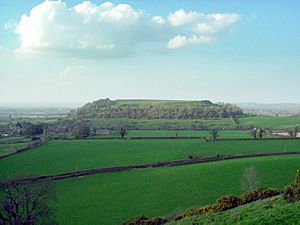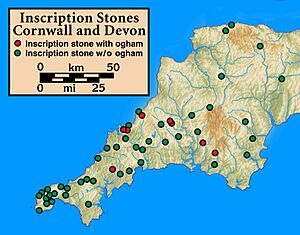Dumnonia facts for kids
Quick facts for kids Dumnonia |
|
| Geography | |
| Capital | Isca Dumnoniorum (Exeter) (before c. 400) Tintagel |
|---|---|
| Location | Devon and Cornwall, and parts of Somerset and Dorset |
| Rulers | Kings of Dumnonia |
Dumnonia was an ancient kingdom in what is now South West England. It existed after the Roman Empire left Britain, from the late 300s to the late 700s AD. This kingdom was mainly in the area we now call Devon. It also included parts of Cornwall and Somerset.
Over time, Dumnonia's eastern border changed. This happened as the Anglo-Saxon kingdom of Wessex slowly expanded westwards. Sometimes, you might see the name spelled Damnonia or Domnonia. The name is linked to a region in modern Brittany, France, called Domnonée.
Contents
What's in a Name? The Kingdom of Dumnonia
The name Dumnonia comes from the Dumnonii. This was a British Celtic tribe living in the south-west when the Romans arrived. The ancient writer Ptolemy mentioned them in his book Geography.
The name Dumnonia means "deep" or "world" in an old Celtic language. Other groups with similar names lived in Scotland and Ireland. Later, the English people from Wessex called this area "West Wales." They called its people Defnas, which meant "men of Dumnonia."
In the old Welsh language, the area was called Dyfneint. This name is still used today in the county name Devon. The names of Cornwall (Kernow) and Brittany (Brezhoneg) also have similar roots.
Some people from Dumnonia moved to Armorica (modern Brittany) in the 400s and 500s AD. They set up a new kingdom there, also called Domnonée. This shows the close links between these areas.
Before the Romans, the Dumnonii lived across the south-west. Their land stretched as far east as the River Parrett in Somerset. The Romans later drew a border between the areas governed from Exeter and those from Dorchester.
Life and Work in Dumnonia
The people of Dumnonia had strong connections with Wales, Ireland, and Armorica. This was shown in their pottery and culture. They spoke a Brythonic language. This language is the ancestor of today's Cornish and Breton.
Some Irish people, called the Déisi, also settled in Dumnonia. They left behind special stones with carvings called Ogham. These carvings were sometimes in Ogham, sometimes in Latin, or both.
Besides fishing and agriculture, the main industry was tin mining. Tin had been traded from this area for a very long time. It was sent from ports like Ictis (possibly St Michael's Mount). Tin mining continued even during Roman times. It was very important for trade with other parts of Europe.
Christianity continued in Dumnonia after the Romans left. Many old Christian burial sites from Roman times were still used. In the 400s and 500s, saints from Ireland and Wales helped spread Christianity. Important monasteries were found at Bodmin and Glastonbury.
Where People Lived: Dumnonian Settlements
Around 55 AD, the Romans built a fort at Isca Dumnoniorum, which is now Exeter. However, the area west of Exeter was not very Romanized. Unlike other parts of Britain, Dumnonia had few Roman villas. Instead, many older settlements from the Romano-British period continued to be used.

Old Iron Age hillforts, like Hembury and Cadbury Castle, were made stronger after the Romans left. They became homes for chieftains or kings. Other important places, like Tintagel, were also rebuilt.
Local discoveries show that small, enclosed farms called rounds were still used. But later, in the 600s and 700s, these were replaced by open farms. These new farms often had names starting with tre(f)-, which is a Brythonic word.
Exeter, called Caer Uisc by the Britons, later became an important Saxon town. However, some Dumnonian Britons still lived there until the 900s. By the mid-800s, the royal family might have moved further west to Lis-Cerruyt (modern Liskeard). This was because the West Saxons were advancing.
Some historians think the rulers of Dumnonia moved around. They might have stayed at different royal homes, like Tintagel and Cadbury Castle, at different times. They may even have owned land in Brittany across the Channel.
The Story of Dumnonia and Its Rulers
Dumnonia was under Roman rule, but its people likely kept a lot of local control. The history of Dumnonia after the Romans is a bit tricky. It comes from many old writings that mix facts, legends, and confused stories.
Battles with the Saxons
In 577, the Saxons won a big battle at Deorham. This cut off Dumnonia from its Welsh allies by land. But sea travel was still easy, so it might not have been a huge problem.
Around 614, the Britons fought another battle at Beandun. This was probably near Axmouth in Devon. In 632, the Britons were still holding Exeter. Some stories say they bravely defended it against Penda of Mercia.
Around 658, the West Saxons won a battle at Peonnum (possibly Penselwood in Somerset). This victory meant the Saxons took over the eastern part of Dumnonia for good.
In 710, King Geraint was defeated by King Ine of Wessex. But in 722, the British won a battle in Cornwall at Hehil. By about 755, the Saxon army was putting a lot of pressure on Dumnonia.
Between 813 and 822, Egbert of Wessex led campaigns in Devon. These likely led to the conquest of most of Dumnonia. Only a smaller part, what we now call Cornwall, remained. This area was known as Cerniu or Kernow. The Anglo-Saxons called it "West Wales."

In 825, a battle was fought between the "Welsh" (Dumnonians) and the Anglo-Saxons at Gafulforda (perhaps Galford in Devon). We don't know who won this battle. In 838, the "West Welsh" and Danish forces rebelled. But Egbert crushed them at the battle of Hingston Down.
By 870, the Cornish bishop accepted the authority of Canterbury. The last known Cornish king, Donyarth, died in 875. By the 880s, Wessex controlled parts of Cornwall. Around 936, Athelstan forced the Britons out of Exeter and the rest of Devon. He set the River Tamar as Cornwall's border.
Devon was fully part of England by the time of Edward the Confessor.
Dumnonia's Lasting Legacy in Cornwall and Brittany
Two groups of people from Dumnonia moved to Armorica (Brittany). Some historians think this led to rulers who governed both in Britain and Brittany. This might explain why some rulers had the same names in both places.
There are also many similar saints and place names in Insular Celtic areas. The Cornish (Kernowek) and Breton (Brezhoneg) languages are also very similar.
Cornwall kept its language and culture. But Devon's culture changed a lot by the time the Saxons arrived. This was partly because many Britons moved from Dumnonia to Armorica.
The region of Cornouaille in Brittany is named after descendants from Cornwall. The region of Domnonée in Brittany is linked to the ancient Dumnonia.
There is a debate about where King Arthur's famous Battle of Mount Badon took place. In this battle, the Britons fought off the Anglo-Saxons. Most historians think it was fought outside Dumnonia, perhaps at Bath. Some traditions say Arthur's last battle, Camlann, was fought in Cornwall.
|
See also
 In Spanish: Dumnonia para niños
In Spanish: Dumnonia para niños


